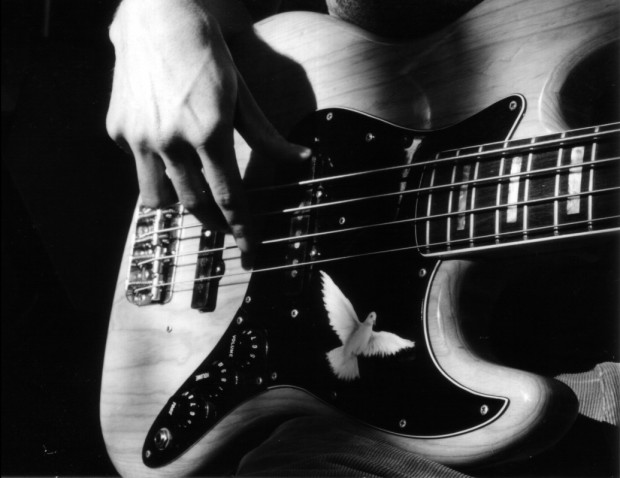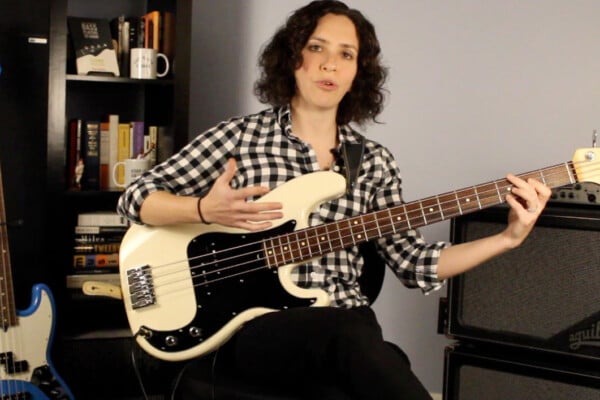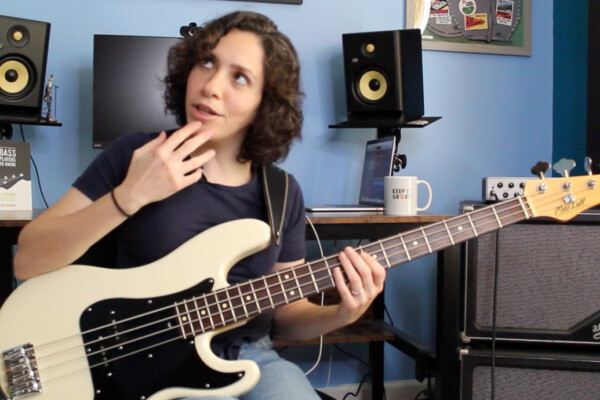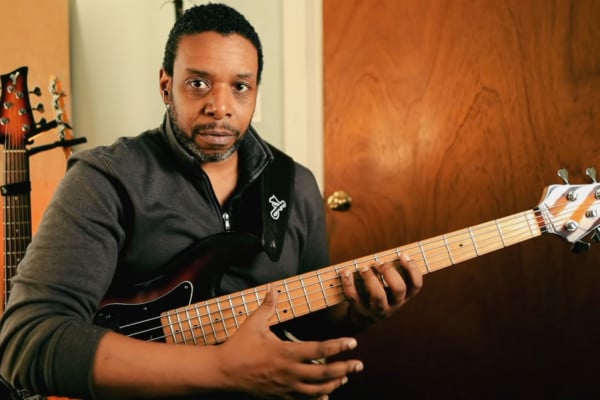Solving Finger Pain To Continue Practicing

Q: As a bass player, having practiced all day until one’s fingernails are aching, what is the solution for a quick pain relief so I can continue to practice the next day, without skipping a day?
A: While I can’t imagine what kind of practice makes your fingernails hurt (double thumb workouts?), I do have some thoughts.
I worry, if your fingernails are hurting when you play, that you may be playing too hard (like, way too hard). Evaluate your technique. Be on the lookout for extreme movements in either hand and/or gripping the neck too hard.
Gary Willis has a great way of discerning the appropriate fretting pressure. I remember reading an article where he talked about pressing down pretty hard on a note with his fretting hand and very slowly releasing the pressure until the note buzzed. Just a hair more pressure than “note buzz” is what he decided was required by his fretting hand. I experimented with that back in the day and found it to be a pretty solid way to explore that side of my playing.
It’s possible that your action may be set far too high as well. I can remember my first bass, after years of playing – but never even thinking of tweaking the action – my strings were a solid 3/4 of an inch off of the fretboard. It was way too hard to play, and I didn’t even know it until I tried another bass and discovered that playing the bass didn’t need to be so hard on my fretting hand. While everyone has a difference preference, I like my action to be high enough that it doesn’t fret out when I pluck fairly hard, but no higher than necessary. While I’m writing this on the road and don’t have access to any way to measure my action, I would guess that it is between an 8th and a quarter of an inch above the fretboard at the 12th fret. While I used to set my action as low as possible, I’ve found that my tone suffers and have found myself playing with relatively higher action as the years pass.
Also evaluate your plucking hand. There’s no need for any finger to move much more than an inch at the tip. If you look at your fretting hand and see your fingers flying up and down, you might be plucking too hard, which can lead to strain. That said, there are times when I intentionally “over-pluck” in order to get a hard, growly, metal-like attack, but I’m still pretty controlled with it. Just try to insure that you are not moving much more than is absolutely necessary to get the sound you want. This will keep you from tiring yourself out and possibly hurting yourself over time.
If you are using your thumb like a pick, you might try switching to an actual pick if it’s causing you that much pain. A pick would give you the same aggressive tone while taking the strain off of your fingers. You’d likely find that, as you acclimate to the technique, you actually have more control over your sound with a pick.
Again, whether you use your finger like a pick or are exploring double-thumbing, efficiency is key. You should be striking the string (in either direction) with about a quarter inch of your finger. Otherwise, you’ll likely be getting more “grab” than is ideal and possibly overexerting yourself in the process. When I was young and exploring slap bass lines, my teacher asked if I broke a lot of strings. I did. It was for this very reason. He noticed me grabbing my “pops” closer to my first knuckle. I was using way too much finger and as a result, I was yanking the strings around. My tone suffered, my time-feel suffered and it was way harder than it should’ve been. Once I corrected the technique, slowly, over time, I stopped breaking strings and my feel was much improved.
Regardless of how you play, there is one thing I want you to keep in mind above all else. Do not play through the pain. If it hurts, take a break. If it always hurts, re-evaluate your technique and slow down your practice so you can really take a look at how you play and make adjustments. It might be a good idea to ask your teacher or find one who’s playing you’d like to emulate and explore. Get them to take a close look at how you play and talk about what kind of sound you’d like to get out of the instrument. If you can find a good teacher, they will most likely be able to help you make the necessary micro-adjustments you need to make in order to get more bang for your buck when you practice.
It’s immensely helpful to find a good teacher who can help you avoid or correct bad habits and reinforce good posture and technique.
Otherwise, best case scenario? You eventually have to spend months or years fixing your deeply ingrained bad habits. Worse case scenario? You cause yourself injury and have to take time off from the instrument all together (or worse).
Pain is there to tell you something. Make sure that you fully explore what is hurting and why and move to correct it as soon as possible. Of course, whenever we start doing something new – and especially when we first begin playing and try to practice every day – things are going to get sore while our body acclimates, builds callouses, strengthens muscles and refines motion. Blisters and sore fingers are a part of the process for the first few years but you have to be careful not to overdo anything. Rest the things that hurt, when they hurt. That doesn’t mean that you can’t work on music or play the instrument when your fingers get tired, but you might have to get creative or work on a different aspect of music while you give your fingers a break. Read up on theory, scales, modes, etc. If you fretting hand is cramping up, practice rhythm and technique over a muted note or open string with your fretting hand. If you’re getting blisters on your thumb when working on slapping, work on finger style stuff for a while, and vice-versa. Listening to new music is important as well. Don’t feel guilty putting the instrument down and listening intently to some new music!
There are endless things to work on when developing (and we’re always developing), you just have to get creative and be smart about what you work on and when to take a break from any one thing.
Seeing as we all likely have experience dealing with fatigue and pain in the shed, let us all know your experiences in the comments below!
Have a question for Damian Erskine? Send it to [email protected]. Check out Damian’s instructional books, Right Hand Drive and The Improviser’s Path.




What can you add about playing a long-scale (34″) bas with a small hand? Are their exercises to help make the long stretches more “palatable” – especially on the intervals at long-end of the neck?
I have a super long scale (37″). You just have to keep working on that end until it becomes comfortable. Anylize your fingering positions and ask yourself if there is a more efficient way.
I also have small hand and the middle finger of my fretting (left) hand is crooked sideways (but fully operational). I remember commuting by bus and doing hard stretches on the left hand by doing the metal horns (index and little finger extended) and then pushing them apart on a solid surface. It does work, hurts rather a lot and if you overdo it, you might damage your tendons. My right hand became much more flexible and strong after i started practicing aikido with its (sometimes extremely) painful wrist and elbow locks.